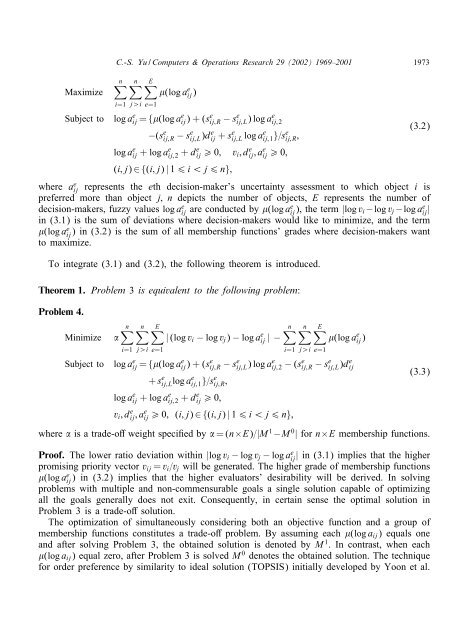A GP-AHP method for solving group decision-making fuzzy AHP ...
A GP-AHP method for solving group decision-making fuzzy AHP ...
A GP-AHP method for solving group decision-making fuzzy AHP ...
You also want an ePaper? Increase the reach of your titles
YUMPU automatically turns print PDFs into web optimized ePapers that Google loves.
Maximize<br />
C.-S. Yu / Computers & Operations Research 29 (2002) 1969–2001 1973<br />
n�<br />
n�<br />
E�<br />
i=1 j¿i e=1<br />
(log a e ij)<br />
Subject to log a e ij = { (log a e ij)+(s e ij;R − s e ij;L) log a e ij;2<br />
−(s e ij;R − s e ij;L)d e ij + s e ij;L log a e ij;1 }=se ij;R;<br />
log ae ij + log ae ij;2 + de ij ¿ 0; vi;de ij;ae ij ¿ 0;<br />
(i; j) ∈{(i; j) | 1 6 i¡j6 n};<br />
(3.2)<br />
where ae ij represents the eth <strong>decision</strong>-maker’s uncertainty assessment to which object i is<br />
preferred more than object j; n depicts the number of objects, E represents the number of<br />
<strong>decision</strong>-makers, <strong>fuzzy</strong> values log ae ij are conducted by (log aeij ), the term |log vi −log vj −log ae ij |<br />
in (3.1) is the sum of deviations where <strong>decision</strong>-makers would like to minimize, and the term<br />
(log ae ij ) in (3.2) is the sum of all membership functions’ grades where <strong>decision</strong>-makers want<br />
to maximize.<br />
To integrate (3.1) and (3.2), the following theorem is introduced.<br />
Theorem 1. Problem 3 is equivalent to the following problem:<br />
Problem 4.<br />
Minimize<br />
n�<br />
n�<br />
i=1 j¿i e=1<br />
E�<br />
| (log vi − log vj) − log ae ij |−<br />
n�<br />
n�<br />
E�<br />
i=1 j¿i e=1<br />
(log a e ij)<br />
Subject to log a e ij = { (log a e ij)+(s e ij;R − s e ij;L) log a e ij;2 − (se ij;R − s e ij;L)d e ij<br />
+ s e ij;Llog a e ij;1 }=se ij;R;<br />
log ae ij + log ae ij;2 + de ij ¿ 0;<br />
vi;de ij;ae ij ¿ 0; (i; j) ∈{(i; j) | 1 6 i¡j6 n};<br />
(3.3)<br />
where is a trade-o weight speci ed by =(n×E)=|M 1 −M 0 | <strong>for</strong> n×E membership functions.<br />
Proof. The lower ratio deviation within |log vi − log vj − log ae ij | in (3.1) implies that the higher<br />
promising priority vector vij = vi=vj will be generated. The higher grade of membership functions<br />
(log ae ij ) in (3.2) implies that the higher evaluators’ desirability will be derived. In <strong>solving</strong><br />
problems with multiple and non-commensurable goals a single solution capable of optimizing<br />
all the goals generally does not exit. Consequently, in certain sense the optimal solution in<br />
Problem 3 is a trade-o solution.<br />
The optimization of simultaneously considering both an objective function and a <strong>group</strong> of<br />
membership functions constitutes a trade-o problem. By assuming each (log aij) equals one<br />
and after <strong>solving</strong> Problem 3, the obtained solution is denoted by M 1 . In contrast, when each<br />
(log aij) equal zero, after Problem 3 is solved M 0 denotes the obtained solution. The technique<br />
<strong>for</strong> order preference by similarity to ideal solution (TOPSIS) initially developed by Yoon et al.









